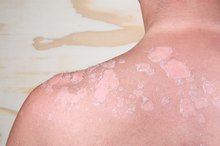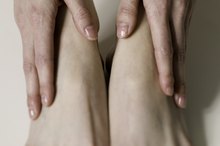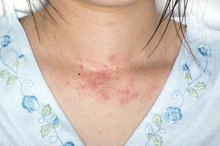What does fact checked mean?
At Healthfully, we strive to deliver objective content that is accurate and up-to-date. Our team periodically reviews articles in order to ensure content quality. The sources cited below consist of evidence from peer-reviewed journals, prominent medical organizations, academic associations, and government data.
- Cleveland Clinic: Foot and Skin Related Complications of Diabetes
- Mayo Clinic: Type 2 Diabetes Complications
The information contained on this site is for informational purposes only, and should not be used as a substitute for the advice of a professional health care provider. Please check with the appropriate physician regarding health questions and concerns. Although we strive to deliver accurate and up-to-date information, no guarantee to that effect is made.
Brown Spots on the Legs of a Diabetic
Skin disorders are sometimes the first sign that a person has diabetes. Diabetes can affect every portion of a person’s body, including his skin. In fact, about 33 percent of diabetic people experience a skin disorder that’s either affected or caused by diabetes at some point in their lifetimes, according to the American Diabetes Association (ADA) 1. Some skin conditions can cause brown spots on a person’s legs.
Identification
Three skin conditions are likely to cause brown spots on the legs of a diabetic. In the condition called diabetic dermopathy, diabetes affects tiny blood vessels that supply a person’s skin with blood. Dermopathy most often appears as light brown, scaly patches on the front of a person’s legs, according to the Cleveland Clinic. These can be oval or circular and look similar to age spots.
Acanthosis nigricans is another condition. It results in tan or brown raised areas. These can show up on the knees but are more likely to appear at the groin, on the sides of the neck and in armpits, according to the ADA.
With disseminated granuloma annulare, red-brown, red or skin colored rashes that have a defined ring or arc shape appear as raised areas on the skin. These rashes most often occur on the legs and other areas of the body far from the trunk area, according to the ADA.
- Three skin conditions are likely to cause brown spots on the legs of a diabetic.
- With disseminated granuloma annulare, red-brown, red or skin colored rashes that have a defined ring or arc shape appear as raised areas on the skin.
Effects
Rashlike Pigmentation on the Foot
Learn More
Diabetic dermopathy is sometimes referred to as “skin spots.” Although unsightly, it doesn't itch, blister or hurt. It's a harmless condition that does not require treatment, the ADA says.
Treatment
Acanthosis Nigricans usually occurs in people who are obese. Some creams can improve the appearance of the spots, but the best treatment is weight loss, according to the ADA. Topical treatments that improve appearance include retinoids, alpha hydroxyl acids and salicylic or lactic acid, advises the American Osteopathic College of Dermatology.
People who have disseminated granuloma annulare should see a doctor, the ADA says. Treatment often isn’t needed, but some people benefit from topical steroid medications such as hydrocortisone, the Cleveland Clinic says.
- Acanthosis Nigricans usually occurs in people who are obese.
- Some creams can improve the appearance of the spots, but the best treatment is weight loss, according to the ADA.
Considerations
Causes of Dark Spots on Your Legs
Learn More
Age spots also can appear on the legs of a diabetic but aren't directly caused by the diabetes. These are pigment collections that are caused by sun exposure, Aetna’s InteliHealth says. The pigment collects in response to areas that are injured due to thin skin or high sun exposure, and are most common among people 55 and older. These do not require treatment.
- Age spots also can appear on the legs of a diabetic but aren't directly caused by the diabetes.
- The pigment collects in response to areas that are injured due to thin skin or high sun exposure, and are most common among people 55 and older.
Prevention/Solution
The most important factor in preventing skin complications such as brown spots is keeping diabetes under control, the Mayo Clinic says 123. People who are diabetic need to carefully follow health care provider advice on exercise, nutrition and medication and keep their blood glucose levels inside the recommended range, the Cleveland Clinic says. Proper skin can help reduce risk of brown spots and other skin problems as well. Age spots can be prevented by limiting the amount of time skin is exposed to the sun.
- The most important factor in preventing skin complications such as brown spots is keeping diabetes under control, the Mayo Clinic says 1.
- Age spots can be prevented by limiting the amount of time skin is exposed to the sun.
Related Articles
References
- American Diabetes Association: Skin Complications
- Cleveland Clinic: Foot and Skin Related Complications of Diabetes
- Mayo Clinic: Type 2 Diabetes Complications
- Duff M, Demidova O, Blackburn S, Shubrook J. Cutaneous manifestations of diabetes mellitus. Clin Diabetes. 2015;33(1):40-8. doi:10.2337/diaclin.33.1.40
- Rosen J, Yosipovitch G. Skin manifestations of diabetes mellitus. In: Feingold KR, Anawalt B, Boyce A, et al., editors. Endotext [Internet]. South Dartmouth (MA): MDText.com, Inc.; 2000-. Updated January 4, 2018.
- American Diabetes Association. Skin complications.
- Alirezaei P, Farshchian M. Granuloma annulare: Relationship to diabetes mellitus, thyroid disorders and tuberculin skin test. Clin Cosmet Investig Dermatol. 2017;10:141-145. doi:10.2147/CCID.S129187
Writer Bio
Linda Tarr Kent is a reporter and editor with more than 20 years experience at Gannett Company Inc., The McClatchy Company, Sound Publishing Inc., Mach Publishing, MomFit The Movement and other companies. Her area of expertise is health and fitness. She is a Bosu fitness and stand-up paddle surfing instructor. Kent holds a bachelor's degree in journalism from Washington State University.









